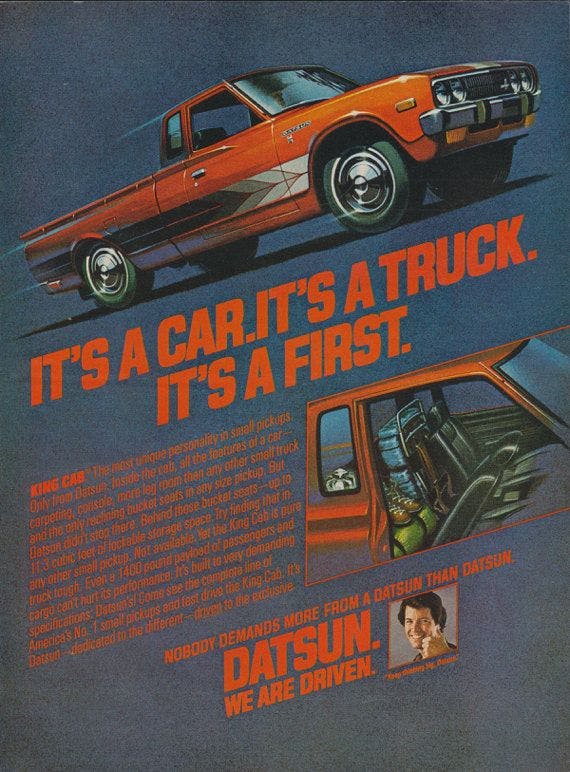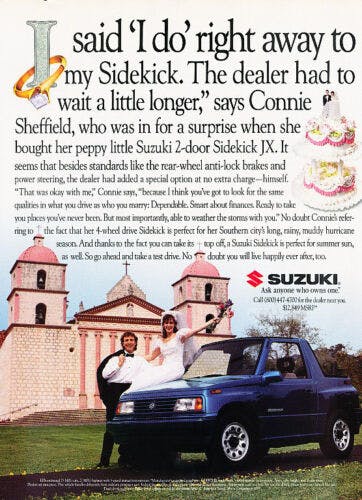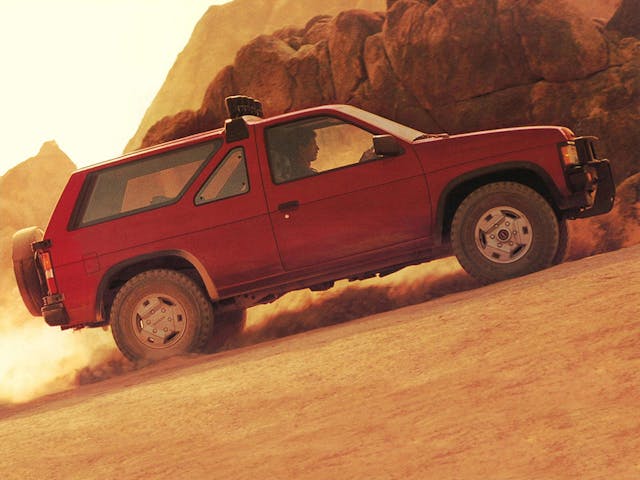4 rad Japanese trucks under $10K
Fun fact: Toyota is not the only Japanese automaker that has produced trucks in the last fifty years.
OK, maybe you already knew that. But the collector vehicle market seems to think otherwise. We’re seeing major price gains for practically every truck with a Toyota badge—classic FJs, of course, but also the recently departed FJ Cruiser and the still-for-sale 4Runners. Other brands, not so much.
No doubt, Toyota trucks, long beloved by everyone from small-time contractors to UNICEF troops and Top Gear hosts for their tough looks and reliability, deserve their day in the sun. But that doesn’t make competitors any less great. Indeed, for those of us who want to use these trucks for their originally intended purpose—dependable, versatile, and cool transportation—these alternatives now have a leg up simply because they remain affordable.

1972–1979 Datsun 620
Don’t shame the Datsun 620 for never being as rugged and capable off-road as the Toyota pickup—it was never designed to be. From the start, Datsun marketed the 620 as a car-truck combo, and nearly half of buyers claimed they never used it for “work.” Remember, this was a time when people only bought trucks when they had to. Datsun helped change that.
Initially powered by a 96-hp, 1.6-liter “L16” 4-cylinder, displacement grew through the years until 1975, when Datsun graced the 620 with its 110-hp, 2.0-liter “L20B.” A couple years later, an optional five-speed manual was introduced. At just under 2300 pounds, the 620 makes for a great starting point for tuning, which might explain its popularity among young collectors.
Indeed, despite being nearly 50 years old, the 620 is beloved by enthusiasts in their twenties and thirties. More than half of all the folks calling us for quotes on insurance on 620s are millennials or younger. Gen-Z callers alone—who presently make of a tiny sliver of the overall collector vehicle market—account for 16 percent of the interest.
One caveat for these eager young collectors to keep in mind is how previous owners may have cared for—or not cared for—their trucks. In particular, 620s were, like the contemporary Datsun 510 coupes, a hotbed for period modifications. Unlike 510s and also unlike many Toyota pickups, these under-appreciated Nissans can still be had in great condition for less than $10,000.

1985–1995 Nissan Pathfinder
Of all the price disparities we’re seeing in the Japanese truck market right now, this could be the biggest headscratcher. The original Pathfinder has gone mostly ignored while 4Runner values have climbed.
This could be due to the reputation of its successors. Whereas the 4Runner has remained a body-on-frame off-roader since its inception, the Pathfinder eventually morphed into a comfortable commuter and today lives on as a family-hauling, car-based crossover.
It wasn’t always this way. The Pathfinder debuted in the mid-1980s as a two-door, body-on-frame SUV that shared many of its components with a pickup truck—the Nissan Hardbody. To enhance its on-road comfort and off-road capability, the Pathfinder had an independent front suspension and a five-link coil suspension in the rear; the 4Runner adopted an independent front suspension by the late 1980s, but didn’t offer coil rear suspension until the second generation in 1990. And just like the 4Runner, the Pathfinder could be had with a powerful V-6—but its six was shared with the Nissan Z, which is arguably way cooler than a Camry.
Some may argue that the Pathfinder is more stylish than the 4Runner. I am one of these people. The rounded box fenders look more deliberate and the three vents above the grille make the Nissan stand a part from other ’80s trucks.
Even those who don’t share my bias will have to concede one major advantage for Pathfinders compared to their old rivals: They’re much, much cheaper. That’s been true for some time but has only become more apparent as Toyotas have taken off. These days, Pathfinder values, as measured by our insurance data, are about half those of 4Runners. Are they every bit as capable? Perhaps not. They don’t have as much support in the off-roading aftermarket, and you don’t see many Pathfinder rock crawlers. But, like any Japanese truck from the era, they are incredibly reliable.

1989-1999 Suzuki Sidekick
The ad above implies that Connie bought a Sidekick and then married her dealer. We don’t know how the marriage worked out, but we can say that buying a Sidekick was a wise life choice.
The box-fendered younger sibling to the love-it-or-hate-it Samurai fixed many of the Samurai’s “bugs” (which some off-roaders would call “features”). In particular, the Sidekick was given an independent front suspension with coilovers all around instead of the Samurai’s solid front axle and stiff four-corner leaf springs. Although this suggests a trade-off in capability, the Sidekick (in Geo Tracker guise) beat out a Samurai and Jeep Wrangler(!) in a 1989 Car and Driver off-road comparison test. The Sidekick had a fuel-injected 1.6-liter four-cylinder pushing 100 hp in 16-valve form—a huge improvement from the Samurai’s notoriously underpowered 63-hp carbureted 1.3-liter.
More proof that the Sidekick is legitimately rugged can be found, in all places, in global shipping data. Many Sidekicks and Trackers have been exported out of the United States in the past decade, but 2013 was a highpoint. Number one destination? Yemen. If you read up on events around that time, you might understand why.
Collectors at home are beginning to appreciate the Suzuki’s charming qualities. Although values for Sidekicks have essentially remained flat, the number of them on Hagerty policies has effectively doubled every year since 2017—a good indication that more people consider them collectible. You can join the club for around $5K–$7K, which will buy you one in great condition; the best Sidekick in the world will barely break $20K.

1999–2001 Isuzu VehiCross
Whereas most Japanese trucks can and must be considered in relation to other Japanese trucks—the gold-standard Toyotas in particular—the Isuzu VehiCross stands on its own.
Just look at the thing!
What other company would build a two-door SUV with wild and controversial styling and a racing suspension with external-reservoir shocks? The closest modern comparison is the Toyota FJ Cruiser, but it was conservatively styled by comparison and, in any event, now costs more than twice as much.
There is a conception that the VehiCross was a sales failure—that Isuzu look too big of a swing and alienated the general population. False. The VehiCross was intended to be a limited-production vehicle—Isuzu used ceramic tooling dies instead of steel ones to stamp the oddly shaped body panels, which reduced cost and production time at the expense of tooling longevity. The dies wore out after just under 6000 VehiCross were produced.
It’s harder to argue, though, that Isuzu itself succeeded, at least when it comes to the U.S. passenger-car market. where the automaker had a limited dealer network. Worse, it relied heavily on a partnership with General Motors for products, and that pipeline dried up practically overnight in 2009.
Isuzu’s footprint in the United States—always small and now non-existent—limits the audience for the VehiCross, which is why this interesting-looking, capable SUV can still be found for under $10,000. For now.


